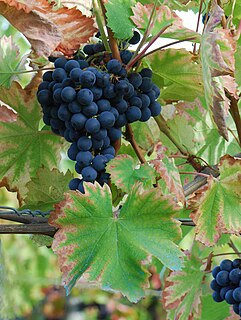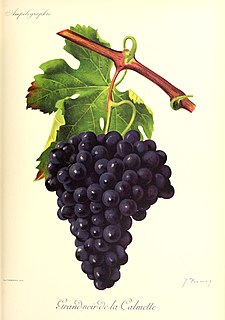Related Research Articles

Syrah, also known as Shiraz, is a dark-skinned grape variety grown throughout the world and used primarily to produce red wine. In 1999, Syrah was found to be the offspring of two obscure grapes from southeastern France, Dureza and Mondeuse Blanche. Syrah should not be confused with Petite Sirah, a cross of Syrah with Peloursin dating from 1880.

Durif is a variety of red wine grape primarily grown in Australia, California, France, and Israel. Since the end of the 20th century, wineries located in Washington's Yakima River Valley, Maryland, Arizona, Texas, West Virginia, Chile, Mexico's Baja California Peninsula, and Ontario's Niagara Peninsula have also produced wines from Durif grapes. It is the main grape known in the U.S. and Israel as Petite Sirah, with over 90% of the California plantings labeled "Petite Sirah" being Durif grapes; the U.S. Bureau of Alcohol, Tobacco, Firearms and Explosives (ATF) recognizes "Durif" and "Petite Sirah" as synonyms for the same grape. It produces tannic wines with a spicy, plummy flavour. The grape originated as a cross of Syrah pollen germinating a Peloursin plant. On some occasions, Peloursin and Syrah vines may be called Petite Sirah, usually because the varieties are extremely difficult to distinguish in old age.

Aligoté is a white grape used to make dry white wines, especially in the Burgundy region of France where it was first recorded in the 18th century. Since it is tolerant to cold, this variety is also cultivated in Eastern European countries. In 2004, it was the 22nd most planted vine variety in the world at 45,000 hectares.

Mourvèdre is a red wine grape variety grown in many regions around the world including the Rhône and Provence regions of France, the Valencia and Jumilla denominaciones de origen of Spain, as well as the Balearic Islands, California and Washington and the Australian regions of South Australia and New South Wales, as well as South Africa. In addition to making red varietal wines, Mourvèdre is a prominent component in "GSM" blends. The variety is also used to make rosé and port-style fortified wines.
Pascal blanc is a white French wine grape variety grown in the Provence region of southern France. While once more widely planted, this ancient Provençal variety is nearly extinct with only a few plantings left in the Appellation d'Origine Contrôlée (AOC) region of Cassis and some hectares used for experimental vin de pays.
Gros Verdot is a red French wine grape variety that was a historically important grape in the Gironde wine region of Bordeaux but plantings of the variety have been banned in the region since 1946 with the grape no longer being a permitted variety in any AOC Bordeaux wines.
Bouchalès or Grapput is a red French wine grape variety that is grown primarily in Bordeaux and Southwest France wine appellations. Plantings have declined in recent years as the vine has shown high sensitivity to downy mildew and black rot.

Grand Noir de la Calmette is a red teinturier grape variety that is a crossing of Petit Bouschet and Aramon noir created in 1855 by French grape breeder Henri Bouschet at his vineyard in Mauguio in the Hérault department. The grape was named after the breeding station Domaine de la Calmette. As a teinturier, Grand noir is often used to add color to wines that it is blended into but is paler than other choices such as Alicante Bouschet. The vine tends to bud late and has a high productivity but with some susceptibility to the viticultural hazard of powdery mildew.
Peloursin is red French wine grape variety best known for crossing with Syrah to make the red wine grape Durif. The variety is believed to have originated in Isère from the northern Rhône-Alpes region. Today Peloursin can be found in some quantities in California and in the Australia wine region of Victoria.
Mondeuse blanche is a variety of white grape almost exclusively found in and around the Savoy (Savoie) wine region in France. With just 5 hectares of plantations in 1999, it leads a dwindling existence and is used primarily in the VDQS wine Bugey and the AOC Vin de Savoie.

Dureza is a dark-skinned French wine grape variety from the Ardèche department of south central France in the Rhône-Alpes region. The grape is most widely known for being the father vine of Syrah—a discovery that confirmed that the Syrah vine was native to France and not introduced to the country from Persia, Sicily, Egypt or elsewhere, as had been speculated.

Jacquère is a variety of white grape found primarily in the Savoy wine region of France. It is a high-yielding vine variety which is used to produce lightly scented, refreshing and gently aromatic dry white wine, such as Vin de Savoie. Jacquère is the grape used in Apremont wines and is the usual wine paired with cheese fondue. It is also found in Bugey wines.
Terret gris is a white French wine grape variety planted primarily in the Languedoc wine region. It is a mutation of the ancient Vitis vinifera vine Terret. Appellation d'origine contrôlée (AOC) regulations allow the grape to be used in white wines from the Corbières, Coteaux du Languedoc and Minervois AOCs as well as some vin de pays. The vine has a very long history in the region and is capable of producing full bodied wines with crisp acidity.

Caladoc is a red French wine grape variety planted primarily in the southern wine regions such as the Languedoc. The grape is a crossing of Grenache and Malbec created by Paul Truel in 1958 at Institut National de la Recherche Agronomique (INRA).
Étraire de la Dui is a red French wine grape variety that was historically grown in the Rhone and Savoy wine regions. Its numbers were hit hard following the phylloxera epidemic and now only a few plantings remain in Savoy and the southeast fringes of the Rhone valley. According to wine expert Jancis Robinson, the grape produces a wine similar in style to Persan and can produce wine with aging potential.
Meslier-Saint-François is a white French wine grape variety that is now grown predominantly in the Loir-et-Cher department of the Loire Valley. Historically, the grape was found more widely throughout the Loire and western France and was even used in the production of Armagnac. However, for most of the 20th century Meslier-Saint-François has been following a similar route to the Loire grape Arbois with plantings rapidly declining.

Verdesse is a white French wine grape variety grown primarily in the Bugey AOC of eastern France. It is also permitted under the Vin de Savoie AOC for wines produced in the Isère department up to a maximum allowance of 10%. Ampelographers believe that the variety is likely very old and originated along the Drac and Grésivaudan valleys in Isère.

Servanin is a red French wine grape variety grown predominantly in the Isère department in eastern France. While the variety has a long history in the region, plantings have been steadily declining since the early 20th century with the vine now close to extinction.

Persan is a red French wine grape variety that is grown primarily in the Savoie region. While the name hints at a Persian origins for the grape, it is most likely native to the Rhône-Alpes region with the name "Persan" being a corruption of the synonym "Princens" which is also the name of a small hamlet by Saint-Jean-de-Maurienne in Savoie which has been noted since the 17th century for the quality of its vineyards.
Bia blanc is a white French wine grape variety that is no longer commercially cultivated for wine production with only a few plantings existing worldwide in viticultural archives and experimental vineyards. The exact origins of Bia blanc are not yet known though ampelographers have noted that the grapevine shares some morphological similarities to the red Isère grape Peloursin, one of the parent varieties to Petite Sirah (Durif).
References
- ↑ J. Robinson Jancis Robinson's Guide to Wine Grapes pg 89 Oxford University Press 1996 ISBN 0-19-860098-4
- ↑ J. Robinson, J. Harding and J. Vouillamoz Wine Grapes - A complete guide to 1,368 vine varieties, including their origins and flavours pg XXVII Allen Lane 2012 ISBN 978-1-846-14446-2